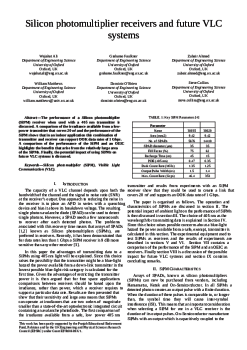Silicon photomultiplier receivers and future VLC systems
Paper
My Second Paper
This work, with Dr. Wajahat Ali as the first author, explores what future visible light communications systems may look like. Much like my other work, this research was performed using Onsemi SiPMs.
Abstract
The performance of a Silicon photomultiplier (SiPM) receiver when used with a 405 nm transmitter is discussed. A comparison of the irradiance available from a low-power transmitter that covers 20 m$^2$ and the performance of the SiPM shows that in an indoor application this combination of transmitter and receiver can support OOK data rates of 1 Gbps. A comparison of the performance of the SiPM and an OEIC highlights the benefits that arise from the relatively large area of the SiPMs. Finally, the potential impact of using SiPMs on future VLC systems is discussed.
Key Findings
Optical wireless transmitters were described using 405 nm light for use with SiPMs. The choice of 405 nm was shown to make sense by analysing the photon detection efficiency of SiPMs, and also considering the spectra of artificial ambient light. At 405 nm, eye safety concerns are present due to a blue-light hazard. The described transmitter is shown to be in the lowest possible risk group, when calculated using an LED standard.
Results show a power efficient receiver able to support a link at a BER of 10$^{-3}$ with a data rate of 1 Gbps. The SiPM used as a receiver is 9 dB more sensitive than a state of the art OEIC that incorporates an APD. Additionally, the large area of the SiPM means that the irradiance that the SiPM requires is more than two orders of magnitude lower than the irradiance required by state of the art APD receivers.
Experimental results also lead to the conclusion that if a SiPM is used in an up-link receiver then a small, low-power, inexpensive LEDs could be used as the transmitter.
